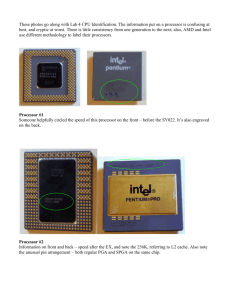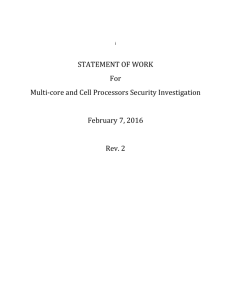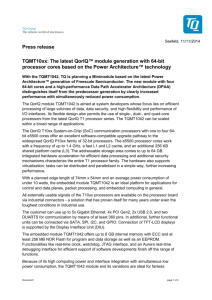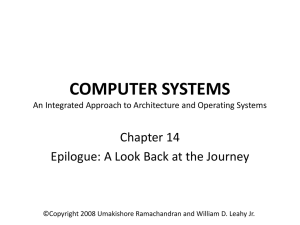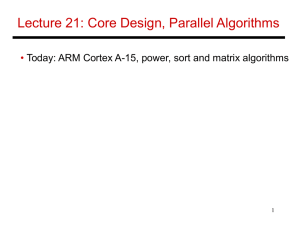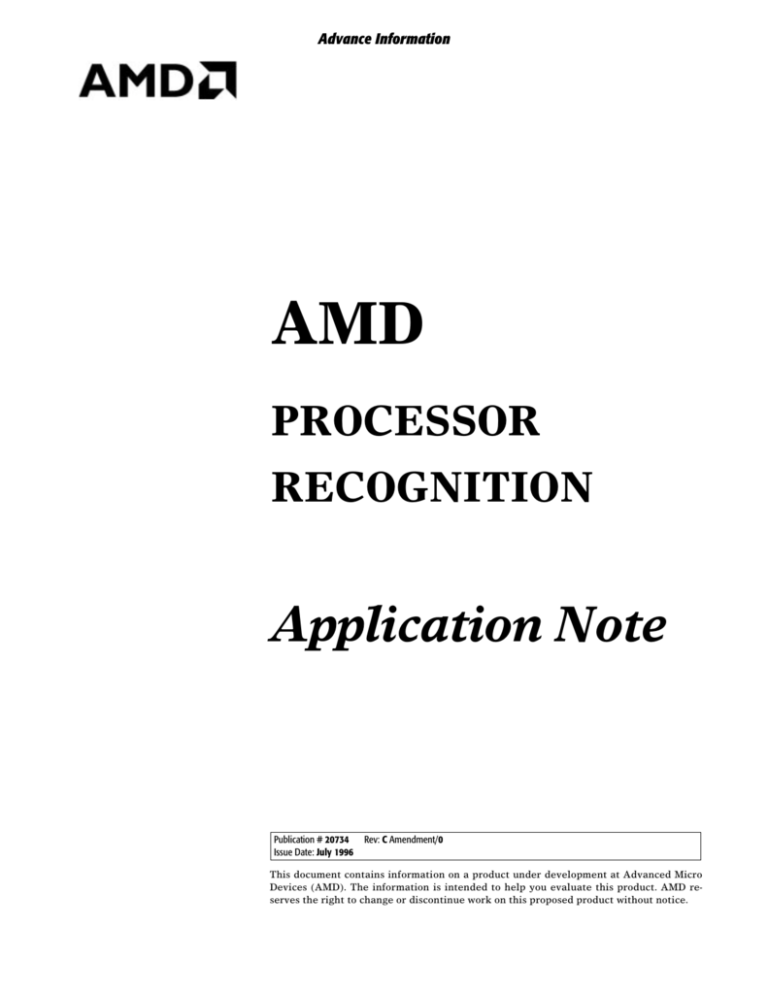
Advance Information
®
AMD
PROCESSOR
RECOGNITION
Application Note
Publication # 20734
Issue Date: July 1996
Rev: C Amendment/0
This document contains information on a product under development at Advanced Micro
Devices (AMD). The information is intended to help you evaluate this product. AMD reserves the right to change or discontinue work on this proposed product without notice.
© 1996 Advanced Micro Devices, Inc. All rights reserved.
Advanced Micro Devices reserves the right to make changes in its products
without notice in order to improve design or performance characteristics.
This publication neither states nor implies any representations or warranties
of any kind, including but not limited to any implied warranty of merchantability or fitness for a particular purpose.
AMD makes no representations or warranties with respect to the accuracy or
completeness of the contents of this publication or the information contained
herein, and reserves the right to make changes at any time, without notice.
AMD disclaims responsibility for any consequences resulting from the use of
the information included herein.
Trademarks
AMD, the AMD logo, and combinations thereof are trademarks of Advanced Micro Devices, Inc.
Am486 is a registered trademark, and K86, Am5X86, AMD-K5, and AMD-K6 are trademarks of Advanced Micro
Devices, Inc.
Other product names used in this publication are for identification purposes only and may be trademarks of their
respective companies.
Advance Information
20734C/0—July 1996
AMD Processor Recognition
Contents
List of Figures . . . . . . . . . . . . . . . . . . . . . . . . . . . . . . . . . . . . . . . . . . . . . iv
List of Tables . . . . . . . . . . . . . . . . . . . . . . . . . . . . . . . . . . . . . . . . . . . . . . iv
Introduction . . . . . . . . . . . . . . . . . . . . . . . . . . . . . . . . . . . . . . . . . . . . . . . 1
Using the CPUID Instruction. . . . . . . . . . . . . . . . . . . . . . . . . . . . . . . . . 2
Overview . . . . . . . . . . . . . . . . . . . . . . . . . . . . . . . . . . . . . . . . . . . . 2
Testing for the CPUID Instruction . . . . . . . . . . . . . . . . . . . . . . . 2
Using CPUID Functions. . . . . . . . . . . . . . . . . . . . . . . . . . . . . . . . 3
Identifying the Processor’s Vendor . . . . . . . . . . . . . . . . . . . . . .
Testing For Extended Functions . . . . . . . . . . . . . . . . . . . . . . . .
Determining the Processor Signature . . . . . . . . . . . . . . . . . . . .
Identifying Supported Features . . . . . . . . . . . . . . . . . . . . . . . . .
AMD Processor Signature . . . . . . . . . . . . . . . . . . . . . . . . . . . . . .
Displaying the Processor’s Name . . . . . . . . . . . . . . . . . . . . . . . .
Displaying Cache Information . . . . . . . . . . . . . . . . . . . . . . . . . .
4
5
5
6
8
9
9
Sample Code . . . . . . . . . . . . . . . . . . . . . . . . . . . . . . . . . . . . . . . . . . . . . 10
Appendix A . . . . . . . . . . . . . . . . . . . . . . . . . . . . . . . . . . . . . . . . . . . . . . 11
CPUID . . . . . . . . . . . . . . . . . . . . . . . . . . . . . . . . . . . . . . . . . . . . . 11
Standard Functions . . . . . . . . . . . . . . . . . . . . . . . . . . . . . . . . . . 12
Extended Functions . . . . . . . . . . . . . . . . . . . . . . . . . . . . . . . . . . 14
Appendix B . . . . . . . . . . . . . . . . . . . . . . . . . . . . . . . . . . . . . . . . . . . . . . 18
Contents
iii
Advance Information
AMD Processor Recognition
20734C/0—July 1996
List of Figures
Figure 1. Contents of EAX Register Returned by Function 1 . . . . . 5
Figure 2. Contents of EAX Register Returned by Extended
Function 8000_0001h . . . . . . . . . . . . . . . . . . . . . . . . . . . . . . 9
List of Tables
Table 1.
Summary of CPUID Functions in AMD Processors . . . . . 4
Table 2.
Summary of Processor Signatures for AMD
Processors . . . . . . . . . . . . . . . . . . . . . . . . . . . . . . . . . . . . . . . 6
Table 3.
Summary of Standard Feature Bits for AMD
Processors . . . . . . . . . . . . . . . . . . . . . . . . . . . . . . . . . . . . . . . 7
Table 4.
Summary of Extended Feature Bits for AMD
Processors . . . . . . . . . . . . . . . . . . . . . . . . . . . . . . . . . . . . . . . 8
Table 5.
Standard Feature Flag Descriptions . . . . . . . . . . . . . . . . 13
Table 6.
Extended Feature Flag Descriptions . . . . . . . . . . . . . . . . 15
Table 7.
EBX Format Returned by Function 8000_0005h . . . . . . 16
Table 8.
ECX Format Returned by Function 8000_0005h . . . . . . 17
Table 9.
EDX Format Returned by Function 8000_0005h . . . . . . 17
Table 10. Values Returned By AMD Processors . . . . . . . . . . . . . . . 18
iv
List of Figures and Tables
Advance Information
AMD Processor Recognition
20734C/0—July 1996
AMD Processor
Recognition
Introduction
Due to the increasing number of choices available in the x86
processor marketplace, the need for a simple way for hardware
and software to identify the type of processor and its feature
set has become critical. The CPUID instruction was added to
the x86 instruction set for this purpose.
The CPUID instruction provides complete information about
the processor (vendor, type, name, etc.) and its capabilities
(features). After detecting the processor and its capabilities,
software can be accurately tuned to the system for maximum
performance and benefit to users. For example, game software
can test the performance level available from a particular
processor by detecting the type or speed of the processor. If the
performance level is high enough, the software can enable
additional capabilities or more advanced algorithms. Another
example involves testing for the presence of multimedia
extensions on the processor. If the software finds this feature
present when it checks the feature bits, it can utilize these
more powerful extensions for dramatically better performance
on new multimedia software.
Introduction
1
Advance Information
AMD Processor Recognition
20734C/0—July 1996
Using the CPUID Instruction
Overview
Software operating at any privilege level can execute the
CPUID instruction to identify the processor and its feature set.
In addition, the CPUID instruction implements multiple
functions, each providing different information about the
processor, including the vendor, model number, revision
(stepping), features, cache organization, and processor name.
The multiple-function approach allows the CPUID instruction
to return a complete picture about the type of processor and its
capabilities — more detailed information than could be
returned by a single function. In addition to gathering all the
information by calling multiple functions, the CPUID
instruction provides the flexibility of making only one call to
obtain the specific data requested once the processor vendor
has been identified.
The functions are divided into two types: standard functions
and extended functions. Standard functions provide a simple
way for software to access information common to all x86
processors. Extended functions provide information on
extensions specific to a vendor’s processors (e.g., AMD’s
processors).
The flexibility of the CPUID instruction allows for the addition
of new CPUID functions in future generations of processors.
Appendix A on page 11 contains a detailed description of the
CPUID instruction.
Testing for the CPUID Instruction
Beginning with the Am486®DX4 processor, all AMD processors
implement the CPUID instruction. In order to avoid an invalid
opcode exception on those processors that do not support the
CPUID instruction, software must first test to determine if the
CPUID instruction is present on the processor. The presence of
the CPUID instruction is indicated by the ID bit (21) in the
EFLAGS register. If this bit is writeable, the CPUID instruction
is implemented on the processor.
2
AMD Processor Recognition
Advance Information
AMD Processor Recognition
20734C/0—July 1996
Software uses the PUSHFD and POPFD instructions to write to
the ID bit in the EFLAGS register. After reading the ID bit, a
comparison determines if this operation changed the value of
the ID bit. If the value changed, the CPUID instruction is
available for identifying the processor and its features. The
following code sample demonstrates the way a program uses
the PUSHFD and POPFD instructions to test the ID bit.
pushfd
pop
eax
mov
ebx, eax
xor
eax, 00200000h
push eax
popfd
pushfd
pop
eax
cmp
eax, ebx
jz
NO_CPUID
;
;
;
;
;
;
;
;
;
;
Save EFLAGS to stack
Store EFLAGS in EAX
Save in EBX for testing later
Switch bit 21
Copy “changed” value to stack
Save “changed” EAX to EFLAGS
Push EFLAGS to top of stack
Store EFLAGS in EAX
See if bit 21 has changed
If no change, no CPUID
Using CPUID Functions
When software uses the CPUID instruction to identify a
pro cessor, it is important tha t it uses the instruct ion
appropriately. The instruction has been defined to make it easy
to identify the type and features of x86 processors
manufactured by many different vendors.
The standard functions (EAX=0 and EAX=1) are the same for
all processors. Having standard functions simplifies software’s
task of testing for and implementing features common to x86
processors. Software can test for these features and, as new x86
processors are released, benefit from these capabilities
immediately.
Extended functions are specific to a vendor’s processors. These
funct ions prov ide additional inf orma tion about AMD
processors that software can use to identify enhanced features
and functions. To test for extended functions, software checks
for “AuthenticAMD” in the vendor identification string
returned by function 0 and for a non-zero value in the EAX
register returned by function 8000_0000h.
Within AMD’s family of processors, different members can
execute a different number of functions. Table 1 summarizes
the CP UI D funct io ns currently im plem ented o n AMD
processors.
Using the CPUID Instruction
3
Advance Information
AMD Processor Recognition
20734C/0—July 1996
Table 1. Summary of CPUID Functions in AMD Processors
(Appendix A contains detailed descriptions of the functions.)
Am486DX4 AMD-K5™ AMD-K5 AMD-K6™
and Am5X86™ Processor Processor Processor
(model 0) (model 1) (model 6)
Processors
Standard
Function
Extended
Function
Description
0
—
Vendor String and Largest Standard
Function Value
X
X
X
X
1
—
Processor Signature and Standard
Feature Bits
X
X
X
X
—
8000_0000h
—
—
X
X
—
8000_0001h
—
—
X
X
—
8000_0002h Processor Name
—
—
X
X
—
8000_0003h Processor Name
—
—
X
X
—
8000_0004h Processor Name
—
—
X
X
—
8000_0005h Cache Information
—
—
X
X
Largest Extended Function Value
Extended Processor Signature and
Extended Feature Bits
Note:
Future versions of these processors may implement additional functions.
Identifying the Processor’s Vendor
Software must execute the standard function EAX=0. The
CPUID instruction returns a 12-character string that identifies
the processor’s vendor. The instruction also returns the largest
st andard function input value defined for the CPUID
instruction on the processor.
For AMD processors, function 0 returns a vendor string of
“AuthenticAMD”. This string informs the software to follow
AMD’s definition for subsequent CPUID functions and the
registers returned for those functions.
Once the software identifies the processor’s vendor, it knows
the definition for all the functions supplied by the CPUID
instruction. By using these functions, the software obtains the
processor information needed to properly tune its functionality
to the capabilities of the processor.
4
AMD Processor Recognition
Advance Information
AMD Processor Recognition
20734C/0—July 1996
Testing For Extended Functions
Once software has identified the processor’s vendor as AMD, it
must test for extended functions by executing function
8000_0000h. The EAX register returns the largest extended
function input value defined for the CPUID instruction on the
processor. If this value is non-zero, extended functions are
supported.
To simplify identifying processors and their features, the AMD
extended functions include all the information provided in the
standard functions as well as the additional AMD-specific
feature enhancements. This duplication can minimize the
number of function calls required by software.
Determining the Processor Signature
Standard function 1 (EAX=1) of the CPUID instruction returns
the standard processor signature and feature bits. The standard
processor signature is returned in the EAX register and
provides information regarding the specific revision (stepping)
and model of the processor and the instruction family level
supported by the processor. The revision level is used to
determine if the processor requires the implementation of
software workarounds. Figure 1 shows the contents of the EAX
register obtained by function 1. Table 2 summarizes the
specific processor signature values returned for AMD
processors.
31
12 11
8 7
43
0
Reserved
Instruction Family
Model
Stepping
11–8
7–4
3–0
Figure 1. Contents of EAX Register Returned by Function 1
Using the CPUID Instruction
5
Advance Information
AMD Processor Recognition
20734C/0—July 1996
Table 2. Summary of Processor Signatures for AMD Processors
(Appendix A contains details on bit locations and values.)
Processor
Instruction
Family
Model
Stepping ID
Am486 and Am5X86
Processors
0100 (4h)
yyyy2
xxxx1
AMD-K5 Processor
(Model 0)
0101b (5h)
0000b (0h)
xxxx1
AMD-K5 Processor
(Model 1)
0101b (5h)
0001b (1h)
xxxx1
AMD-K6 Processor
0101b (5h)
0110b (6h)
xxxx1
Notes:
1. Contact your AMD representative for the latest stepping information.
2. Model identifier information is provided in the AMD BIOS Development Guide, order# 19720.
Identifying Supported Features
The feature bits are returned in the EDX register for two
CPUID functions: standard function 1 and extended function
8000_0001h. Each bit corresponds to a specific feature and
indicates if that feature is present on the processor. Table 3
summarizes the standard feature bits, and Table 4 summarizes
the extended feature bits.
Before using any of the enhanced features added to the latest
generation of processors, software should test each feature bit
returned by functions 1 and 8000_0001h to identify the
capabilities available on the processor. For example, software
must test bit 23 to determine if the processor has multimedia
extensions. Attempting to execute an unavailable feature can
cause errors and exceptions.
6
AMD Processor Recognition
Advance Information
AMD Processor Recognition
20734C/0—July 1996
Table 3. Summary of Standard Feature Bits for AMD Processors
(Appendix A contains details on bit locations and values.)
Feature
Description
Floating-Point Unit
A floating-point unit is available.
Virtual Mode Extensions
Virtual mode extensions are available.
Debugging Extensions
I/O breakpoint debug extensions are supported.
Page Size Extensions
4-Mbyte pages are supported.
Time Stamp Counter
A time stamp counter is available in the processor,
(with RDTSC and CR4 disable bit) and the RDTSC instruction is supported.
Using the CPUID Instruction
K86™ Model-Specific Registers
(with RDMSR and WRMSR)
The K86 model-specific registers are available in the
processor, and the RDMSR and WRMSR instructions
are supported.
Machine Check Exception
The machine check exception is supported.
CMPXCHG8B Instruction
The CMPXCHG8B instruction is supported.
APIC
A local APIC unit is available.
Global Paging Extension
Global paging extensions are available.
Conditional Move Instruction
The conditional move instructions CMOV, FCMOV,
and FCOMI are supported.
Multimedia Extensions
The MMX multimedia extensions are supported.
7
Advance Information
AMD Processor Recognition
20734C/0—July 1996
Table 4. Summary of Extended Feature Bits for AMD Processors
(Appendix A contains details on bit locations and values.)
Feature
Description
Floating-Point Unit
A floating-point unit is available.
Virtual Mode Extensions
Virtual mode extensions are available.
Debugging Extensions
I/O breakpoint debug extensions are supported.
Page Size Extensions
4-Mbyte pages are supported.
Time Stamp Counter
A time stamp counter is available in the processor,
(with RDTSC and CR4 disable bit) and the RDTSC instruction is supported.
K86 Model-Specific Registers
(with RDMSR and WRMSR)
The K86 model-specific registers are available in the
processor, and the RDMSR and WRMSR instructions
are supported.
Machine Check Exception
The machine check exception is supported.
CMPXCHG8B Instruction
The CMPXCHG8B instruction is supported.
Global Paging Extension
Global paging extensions are available.
SYSCALL and SYSRET Extensions
The SYSCALL and SYSRET instructions and
associated extensions are supported.
Integer Conditional Move
Instruction
The integer conditional move instruction CMOV is
supported.
Floating-Point Conditional Move
Instructions
The floating-point conditional move instructions
FCMOV and FCOMI are supported.
Multimedia Extensions
The multimedia extensions (MMX) are supported.
AMD Processor Signature
Extended function 8000_0001h returns the AMD processor
signature. The signature is returned in the EAX register and
provides generation, model, and stepping information for AMD
processors. Figure 2 shows the contents returned in the EAX
register. See Table 2 for a summary of the values returned by
specific AMD processors.
8
AMD Processor Recognition
Advance Information
AMD Processor Recognition
20734C/0—July 1996
31
12 11
8 7
43
0
Reserved
Generation/Family
Model
Stepping
11–8
7–4
3–0
Figure 2. Contents of EAX Register Returned by Extended Function 8000_0001h
Displaying the Processor’s Name
Functions 8000_0002h, 8000_0003h, and 8000_0004h return an
ASCII string containing the name of the processor. These
functions eliminate the need for software to search for the
processor name in a lookup table, a process requiring a large
block of memory and frequent updates. Instead, software can
simply call these three functions to obtain the name string (48
ASCII characters in little endian format) and display it on the
screen. Although the name string can be up to 48 characters in
length, shorter names have the remaining byte locations filled
with the ASCII NULL character (00h). To simplify the display
routines and avoid using screen space, software only needs to
display characters until a NULL character is detected.
Displaying Cache Information
Function 8000_0005h provides cache information for the
processor. Some diagnostic software displays information
about the system and the processor’s configuration. It is
common for this type of software to provide cache size and
organization of information. Function 8000_0005h provides a
simple way for software to obtain information about the on-chip
c a c h e a n d T L B s t r u c t u re s . T h e s iz e an d o r ga n iz at io n
information is returned in the registers as described in
Appendix A on page 11. Software can simply display these
values, eliminating the need for large pieces of code to test the
memory structures.
Using the CPUID Instruction
9
Advance Information
AMD Processor Recognition
20734C/0—July 1996
Sample Code
A code sample that uses the CPUID instruction to identify the
processor and its features is available from AMD’s website at
http://www.amd.com.
10
AMD Processor Recognition
Advance Information
AMD Processor Recognition
20734C/0—July 1996
Appendix A
CPUID
mnemonic
CPUID
Privilege:
Registers Affected:
Flags Affected:
Exceptions Generated:
opcode
description
0F A2h
Identify the processor and its feature set
none
EAX, EBX, ECX, EDX
none
none
The CPUID instruction is an application-level instruction that software executes to
identify the processor and its feature set. This instruction offers multiple functions,
each providing a different set of information about the processor. The CPUID
instruction can be executed from any privilege level. Software can use the
information returned by this instruction to tune its functionality for the specific
processor and its features.
Not all processors implement the CPUID instruction. Therefore, software must test to
determine if the instruction is present on the processor. If the ID bit (21) in the
EFLAGS register is writeable, the CPUID instruction is implemented.
The CPUID instruction supports multiple functions. The information associated with
each function is obtained by executing the CPUID instruction with the function
number in the EAX register. Functions are divided into two types: standard functions
and extended functions. Standard functions are found in the low function space,
0000_0000h–7FFF_FFFFh. In general, all x86 processors have the same standard
function definitions.
Extended functions are defined specifically for processors supplied by the vendor
listed in the vendor identification string. Extended functions are found in the high
function space, 8000_0000h–8FFF_FFFFh. Because not all vendors have defined
extended functions, software must test for their presence on the processor.
AMD processors have extended functions under the following conditions:
■
■
The processor returns the “AuthenticAMD” vendor identification string.
The 8000_0000h function returns a non-zero value in the EAX register.
Appendix A
11
Advance Information
AMD Processor Recognition
20734C/0—July 1996
Standard Functions
Function 0 — Largest Standard Function Input Value and Vendor Identification String
Input:
EAX = 0
Output: EAX = Largest function input value recognized by the CPUID instruction
EBX, EDX, ECX = Vendor identification string
This is a standard function found in all processors implementing the CPUID
instruction. It returns two values. The first value is returned in the EAX register and
indicates the largest standard function value recognized by the processor. The second
value is the vendor identification string. This 12-character ASCII string is returned in
the EBX, EDX, and ECX registers in little endian format.
AMD processors return a vendor identification string of “AuthenticAMD” that
software uses as follows:
■
■
To identify the processor as an AMD processor
To apply AMD’s definition of the CPUID instruction for all additional function
calls
Function 1 — Processor Signature and Standard Feature Flags
Input:
EAX = 1
Output: EAX = Processor Signature
EBX = Reserved
ECX = Reserved
EDX = Standard Feature Flags
Function 1 returns two values — the Processor Signature and the Standard Feature
Flags. The processor signature is returned in the EAX register and identifies the
specific processor by providing information on its type—instruction family, model,
and revision (stepping). The information is formatted as follows:
■
■
■
■
EAX[3–0]
EAX[7–4]
EAX[11–8]
EAX[31–2]
Stepping ID
Model
Instruction Family
Reserved
The standard feature flags are returned in the EDX register and indicate the presence
of specific features. In most cases, a “1” indicates the feature is present, and a “0”
indicates the feature is not present. Table 5 contains a list of the currently defined
standard feature flags. Reserved bits will be used for new features as they are added.
12
AMD Processor Recognition
Advance Information
AMD Processor Recognition
20734C/0—July 1996
Table 5. Standard Feature Flag Descriptions
Bit
Feature
Description
0
Floating-Point Unit
0 = No FPU
1 = FPU Present
1
Virtual Mode Extensions
0 = No Support
1= Support
2
Debugging Extensions
0 = No Support
1= Support
3
Page Size Extensions
0 = No Support
1= Support 4Mbyte Pages
4
Time Stamp Counter (with RDTSC and CR4 disable
bit)
0 = No Support
1= Support
5
K86 Model-Specific Registers (with RDMSR and
WRMSR)
0 = No Support
1= Support
6
Reserved
—
7
Machine Check Exception
0 = No Support
1= Support
8
CMPXCHG8B Instruction
0 = No Support
1= Support
9
APIC*
0 = No Support
1= Support
10–11 Reserved
—
12
Memory Type Range Registers
0 = No Support
1= Support
13
Global Paging Extension*
0 = No Support
1= Support
14
Reserved
—
15
Conditional Move Instruction
0 = No Support
1= Support
16–22 Reserved
23
Multimedia Extensions
24–31 Reserved
—
0 = No Support
1= Support
—
Note:
*
Appendix A
The AMD-K5 processor (model 0) reserves bit 13 and implements feature bit 9 to indicate support for Global Paging Extensions instead of support for APIC.
13
Advance Information
AMD Processor Recognition
20734C/0—July 1996
Extended Functions
Function 8000_0000h — Largest Extended Function Input Value
Input:
EAX = 8000_0000h
Output: EAX = Largest function input value recognized by the CPUID instruction
EBX = Reserved
ECX = Reserved
EDX = Reserved
Function 8000_0000h returns a value in the EAX register that indicates the largest
extended function value recognized by the processor.
Function 8000_0001h — AMD Processor Signature and Extended Feature Flags
Input:
EAX = 8000_0001h
Output: EAX = AMD Processor Signature
EBX = Reserved
ECX = Reserved
EDX = Extended Feature Flags
Function 8000_0001h returns two values — the AMD Processor Signature and the
Extended Feature Flags. The AMD processor signature is returned in the EAX
register and identifies the specific processor by providing information regarding its
type — generation/family, model, and revision (stepping). The information is
formatted as follows:
■
■
■
■
EAX[3–0]
EAX[7–4]
EAX[11–8]
EAX[31–12]
Stepping ID
Model
Generation/Family
Reserved
The extended feature flags are returned in the EDX register and indicate the
presence of specific features found in AMD processors. In most cases, a “1” indicates
the feature is present, and a “0” indicates the feature is not present. Table 6 contains
a list of the currently defined feature flags. Reserved bits will be used for new
features as they are added.
14
AMD Processor Recognition
Advance Information
AMD Processor Recognition
20734C/0—July 1996
Table 6. Extended Feature Flag Descriptions
Bit
Feature
0
Floating-Point Unit
0 = No FPU
1 = FPU Present
1
Virtual Mode Extensions
0 = No Support
1= Support
2
Debugging Extensions
0 = No Support
1= Support
3
Page Size Extensions
0 = No Support
1= Support 4Mbyte Pages
4
Time Stamp Counter (with RDTSC and CR4 disable 0 = No Support
bit)
1= Support
5
K86 Model-Specific Registers (with RDMSR and
WRMSR)
0 = No Support
1= Support
6
Reserved
—
7
Machine Check Exception
0 = No Support
1= Support
8
CMPXCHG8B Instruction
0 = No Support
1= Support
9
Reserved
—
10
SYSCALL and SYSRET Extensions
0 = No Support
1= Support
11–12 Reserved
—
13
Global Paging Extension
0 = No Support
1= Support
14
Reserved
—
15
Integer Conditional Move Instructions
0 = No Support
1= Support
16
Floating-Point Conditional Move Instructions
0 = No Support
1= Support
17–22 Reserved
23
Multimedia Extensions
24–31 Reserved
Appendix A
Description
—
0 = No Support
1= Support
—
15
Advance Information
AMD Processor Recognition
20734C/0—July 1996
Functions 8000_0002h, 8000_0003h, and 8000_0004h — Processor Name String
Input:
EAX = 8000_0002h, 8000_0003h, or 8000_0004h
Output: EAX = Processor Name String
EBX = Processor Name String
ECX = Processor Name String
EDX = Processor Name String
Functions 8000_0002h, 8000_0003h, and 8000_0004h return the processor name string
in the EAX, EBX, ECX, and EDX registers. These three functions use the four
registers to return an ASCII string of up to 48 characters in little endian format. The
NULL character (ASCII 00h) is used to indicate the end of the processor name string.
This feature is useful for processor names that require fewer than 48 characters.
Function 8000_0005h — Cache Information
Input:
EAX = 8000_0005h
Output: EAX = Reserved
EBX = TLB Information
ECX = L1 Data Cache Information
EDX = L1 Instruction Cache Information
Function 8000_0005h returns information about the processor’s on-chip caches.
Tables 7, 8, and 9 provide the format for the information returned by the 8000_0005h
function.
Table 7. EBX Format Returned by Function 8000_0005h
Data TLB
EBX
Instruction TLB
Associativity*
# Entries
Associativity*
# Entries
Bits 31–24
Bits 23–16
Bits 15–8
Bits 7–0
Note:
*
16
Full associativity is indicated by a value of 0FFh.
AMD Processor Recognition
Advance Information
AMD Processor Recognition
20734C/0—July 1996
Table 8. ECX Format Returned by Function 8000_0005h
L1 Data Cache
ECX
Size (Kbytes)
Associativity*
Lines per Tag
Line Size (bytes)
Bits 31–24
Bits 23–16
Bits 15–8
Bits 7–0
Note:
*
Full associativity is indicated by a value of 0FFh.
Table 9. EDX Format Returned by Function 8000_0005h
L1 Instruction Cache
EDX
Size (Kbytes)
Associativity*
Lines per Tag
Line Size (bytes)
Bits 31–24
Bits 23–16
Bits 15–8
Bits 7–0
Note:
*
Appendix A
Full associativity is indicated by a value of 0FFh.
17
Advance Information
AMD Processor Recognition
20734C/0—July 1996
Appendix B
Table 10 contains all the values returned for AMD processors
by the CPUID instruction.
Table 10. Values Returned By AMD Processors
Am486 and
Am5X86
Processors
AMD-K5
Processor
(Model 0)
AMD-K5
Processor
(Model 1)
AMD-K6
Processor
(Model 6)
EAX 0000_0001h
EBX 6874_7541h
ECX 444D_4163h
EDX 6974_6E65h
0000_0001h
6874_7541h
444D_4163h
6974_6E65h
0000_0001h
6874_7541h
444D_4163h
6974_6E65h
0000_0001h
6874_7541h
444D_4163h
6974_6E65h
EAX
EBX
ECX
EDX
0000_04XXh
Reserved
Reserved
0000_0001h
0000_050Xh
Reserved
Reserved
0000_03BFh
0000_051Xh
Reserved
Reserved
0000_21BFh
0000_056Xh
Reserved
Reserved
0080_01BFh
0000_0000h
Undefined
Undefined
Undefined
0000_0000h
Undefined
Undefined
Undefined
8000_0005h
Reserved
Reserved
Reserved
8000_0005h
Reserved
Reserved
Reserved
Undefined
Undefined
Undefined
Undefined
Undefined
Undefined
Undefined
Undefined
0000_051Xh
Reserved
Reserved
0000_21BFh
0000_066Xh
Reserved
Reserved
0080_05BFh
Undefined
Undefined
Undefined
Undefined
Undefined
Undefined
Undefined
Undefined
2D44_4D41h
7428_354Bh
5020_296Dh
6563_6F72h
TBD
TBD
TBD
TBD
Undefined
Undefined
Undefined
Undefined
Undefined
Undefined
Undefined
Undefined
726F_7373h
0000_0000h
0000_0000h
0000_0000h
TBD
TBD
TBD
TBD
Function
Register
Function: 0
Function: 1
Function: 8000_0000h
EAX
EBX
ECX
EDX
Function: 8000_0001h
EAX
EBX
ECX
EDX
Function: 8000_0002h
EAX
EBX
ECX
EDX
Function: 8000_0003h
EAX
EBX
ECX
EDX
18
AMD Processor Recognition
Advance Information
AMD Processor Recognition
20734C/0—July 1996
Table 10. Values Returned By AMD Processors (continued)
Function
Register
Am486 and
Am5X86
Processors
AMD-K5
Processor
(Model 0)
AMD-K5
Processor
(Model 1)
AMD-K6
Processor
(Model 6)
Undefined
Undefined
Undefined
Undefined
Undefined
Undefined
Undefined
Undefined
0000_0000h
0000_0000h
0000_0000h
0000_0000h
TBD
TBD
TBD
TBD
Undefined
Undefined
Undefined
Undefined
Undefined
Undefined
Undefined
Undefined
Reserved
0480_0000h
0804_0120h
1004_0120h
Reserved
0280_0140h
2002_0220h
2002_0220h
Function: 8000_0004h
EAX
EBX
ECX
EDX
Function: 8000_0005h
EAX
EBX
ECX
EDX
Appendix B
19
Advance Information
AMD Processor Recognition
20
20734C/0—July 1996
AMD Processor Recognition



